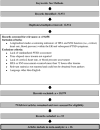Cortisol, heart rate, and blood pressure as early markers of PTSD risk: A systematic review and meta-analysis
- PMID: 27623149
- PMCID: PMC5079809
- DOI: 10.1016/j.cpr.2016.09.001
Cortisol, heart rate, and blood pressure as early markers of PTSD risk: A systematic review and meta-analysis
Abstract
Individuals with posttraumatic stress disorder (PTSD) typically exhibit altered hypothalamic-pituitary-adrenal (HPA) function and sympathetic nervous system (SNS) activity. The goals of this study were to determine whether HPA and SNS alterations in the immediate aftermath of trauma predict subsequent PTSD symptom development and whether inconsistencies observed between studies can be explained by key demographic and methodological factors. This work informs secondary prevention of PTSD by identifying subgroups of trauma survivors at risk for PTSD. This meta-analysis (26 studies, N=5186 individuals) revealed that higher heart rate measured soon after trauma exposure was associated with higher PTSD symptoms subsequently (r=0.13). Neither cortisol (r=-0.07) nor blood pressure (diastolic: r=-0.01; systolic: r=0.02) were associated with PTSD symptoms which may be influenced by methodological limitations. Associations between risk markers (heart rate, cortisol, systolic blood pressure) and PTSD symptoms were in the positive direction for younger samples and negative direction for older samples. These findings extend developmental traumatology models of PTSD by revealing an age-related shift in the presentation of early risk markers. More work will be needed to identify risk markers and pathways to PTSD while addressing methodological limitations in order to shape and target preventive interventions.
Keywords: Blood pressure; Cortisol; Heart-rate; Posttraumatic stress disorder; Traumatic stress.
Copyright © 2016 Elsevier Ltd. All rights reserved.
Conflict of interest statement
The authors report no conflicts of interest.
Figures




References
-
- Agorastos A, Boel JA, Heppner PS, Hager T, Moeller-Bertam T, Haji U, Motazedi A, Yanagi MA, Baker DG, Stiedl O. Dimished vagal activity and blunted diurnal variation of heart rate dynamics in posttraumatic stress disorder. Stress. 2012;3:300–310. - PubMed
-
- al Arab AS, Guedon-Moreau L, Ducrocq F, Molenda S, Duhem S, Salleron J, Chaudieu I, Bert D, Libersa C, Vaiva G. Temporal analysis of heart rate variability as a predictor of posttraumatic stress disorder in road traffic accidents survivors. Journal of Psychiatric Research. 2012;46:790–796. - PubMed
-
- Alarcon HL, Germain A, Clontz AS, Roach E, Nicholas DH, Zenati MS, Peitzman AB, Sperry JL. Predictors of acute posttraumatic stress disorder symptoms following civilian trauma: Highest incidence and severity of symptoms after assault. Journal of Trauma. 2011;72:629–637. - PubMed
-
- American Psychiatric Association. Diagnostic and statistical manual of mental disorders. 5th. Washington, DC: Author; 2013.
-
- Blanchard EB, Hickling EJ, Veazey CH, Buckley TC, Freidenberg BM, Walsh JD, Keefer L. Treatment-related changes in cardiovascular reactivity to trauma cues in motor vehicle accident-related PTSD. Behavior Therapy. 2002;33:417–426.
Publication types
MeSH terms
Substances
Grants and funding
LinkOut - more resources
Full Text Sources
Other Literature Sources
Medical

